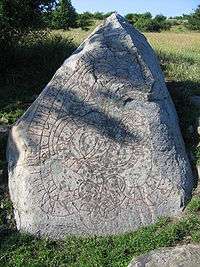Uppland Runic Inscription 11
U 11 is the Rundata designation for a runestone that is located near the ruins of the old king's dwelling at Alsnö hus near Hovgården on the island of Adelsö in Sweden.
| Uppland Runic Inscription 11 | |
|---|---|
 | |
| Created | eleventh century |
| Discovered | Hovgården, Adelsö, Uppland, Sweden |
| Rundata ID | U 11 |
| Runemaster | Unknown |
| Text – Native | |
| Old Norse : Rað þu runaʀ. Rett let rista Toliʀ bryti i roði kunungi. Toliʀ ok Gylla letu ris[ta] ..., þaun hion æftiʀ [si]k(?) mærki ... Hakon bað rista. | |
| Translation | |
| You read the runes! Right let cut them Tolir, bailiff in Roden, to the king. Tolir and Gylla let carve (these runes), this pair after themself as a memorial... Håkon bade carve. | |
Description
This runestone has an intricate design with the runic text within serpents. The inscription is unsigned and is classified as being carved in runestone style Pr4, which is also known as Urnes style. This runestone style is characterized by slim and stylized animals that are interwoven into tight patterns. The animal heads are typically seen in profile with slender almond-shaped eyes and upwardly curled appendages on the noses and the necks.
Tolir is described as being a "bryte," which is an old Swedish word for a thrall who worked as the thralls' foreman. The word "bryte" comes from "to break," in the meaning of breaking bread, so "bryte" can be interpreted as the person who serves out food.
Gylla was Tolir's wife. Håkon is believed to be the reigning king Håkan the Red, who is generally accepted as ruling during the 1070s. This would be consistent with the runic text, which using the word kunungi or kunungr, Old Norse for "king." Because of this, the stone is known as Håkansstenen.
Tranlisteration of runic text into Latin letters
- raþ| |þu : runaʀ : ret : lit : rista : toliʀ : bry[t]i : i roþ : kunuki : toliʀ : a(u)k : gyla : litu : ris... ...- : þaun : hion : eftiʀ ...k : merki srni... haku(n) * (b)aþ : rista[1]
References
- Project Samnordisk Runtextdatabas Svensk - Rundata entry for U 11.
See also
External links
Additional images
| Wikimedia Commons has media related to Hacon Stone (Håkansstenen) at Adelsö. |
 Detail showing the word kunungi or "king."
Detail showing the word kunungi or "king." Drawing of U 11.
Drawing of U 11.